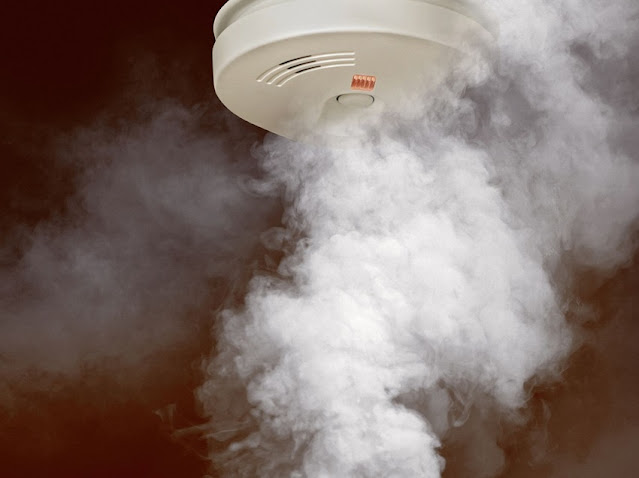Brook Photoelectric Smoke Alarms: A Crucial Component for Fire Safety
A house fire can engulf a room within minutes. The fast and ferocious blaze can devastate a home and kill people. How do you prevent this? By putting in smoke alarms and taking the necessary safety measures. Smoke alarms are an indispensable part of home safety systems, designed to provide early warning in the event of a fire. They save lives. Among the various types of smoke alarms, the Brooks photoelectric smoke alarm, specifically made for Australia’s conditions is known for its efficiency and reliability. Today, we delve into the inner workings of the photoelectric smoke alarm, explaining its functionality and offering valuable tips for homeowners to ensure maximum protection.
How Does a Photoelectric Smoke Alarm Work?
A photoelectric smoke alarm operates on a simple yet effective principle, relying on light and smoke detection to identify potential fire hazards. Inside the smoke alarm, there is an LED light source. This light is directed into a sensing chamber. The sensing chamber contains a photocell or light-sensitive sensor. In normal conditions, the light beam from the LED is dispersed and doesn't reach the sensor. When smoke particles enter the sensing chamber, they scatter the light. This scattered light reaches the photocell, causing it to trigger an alarm. Once the sensor detects smoke, it triggers the smoke alarm's audible alert, which can be a loud siren or a beeping sound. The Brooks photoelectric smoke alarm is particularly effective at detecting smouldering fires, which produce larger smoke particles. They can be cause by a cigarette or charcoal embers, or other items smoke a lot. The early detection is crucial as it provides valuable time for occupants to evacuate the building and for first responders to arrive.
Tips for Proper Installation and Maintenance
To ensure your Brooks smoke detectors function optimally, it's essential to follow these installation and maintenance tips:
Placement
Install smoke alarms on each level of your home and near sleeping areas. Mount them on the ceiling or high on the wall, as smoke rises. Avoid placing alarms too close to bathrooms or kitchens to prevent false alarms.
Interconnection
For maximum safety, interconnect multiple smoke alarms within your home. When one alarm detects smoke, all interconnected alarms will sound simultaneously, providing early warning throughout the house.
Battery Replacement
Test your smoke alarms monthly and replace the batteries at least once a year, or as soon as the low-battery warning signal activates. Many modern smoke alarms come with long-lasting lithium batteries that don't require frequent replacement.
Regular Cleaning
Dust and debris can accumulate inside the sensing chamber, reducing the alarm's effectiveness. Clean your smoke alarms at least once a year using a vacuum cleaner attachment or a can of compressed air.
Replace Every 10 Years
Smoke alarms have a limited lifespan. Replace your Brooks smoke alarm every 10 years to ensure it operates correctly. The manufacture date is usually marked on the back of the alarm.
How Do You 'Hush' a Smoke Alarm?
If your alarm sounds due to cooking fumes or steam from the shower, use the alarm's "hush" or "silence" button to temporarily deactivate it. However, never remove the battery to silence an alarm without addressing the underlying issue.
Professional Installation
If you are uncertain about installing smoke alarms correctly, consider having a professional electrician or technician do it for you to ensure proper placement and wiring.
Solutions for Hearing Impaired People
The beeping sound of common alarms is not a suitable solution for people who are deaf or hard of hearing. They need specialist smoke alarms with a strobe light and a vibrating pad to alert them of an activated fire alarm and give them enough time to evacuate.
Create an Escape Plan
In addition to smoke alarms, it's crucial to have a fire escape plan in place. People tend to panic in emergencies and make rash decisions that can lead to injuries and serious consequences. Therefore, regularly practice the plan with your family to ensure everyone knows what to do in case of a fire.
Additional Safety Measures
While the Brooks smoke detectors is an integral part of fire safety, there are additional measures you can take to enhance your home's protection:
- Carbon Monoxide Detectors: Install carbon monoxide detectors alongside smoke alarms to identify the presence of this deadly, odourless gas. CO detectors should be placed near bedrooms and fuel-burning appliances.
- Fire Extinguishers: Keep fire extinguishers in accessible locations throughout your home and ensure that everyone in the household knows how to use them.
- Fire-Safe Practices: Follow fire-safe practices in your daily life, such as turning off appliances when not in use, keeping flammable materials away from heat sources, and using candles safely.
- Regular Inspections: Schedule regular inspections of your home's electrical and heating systems. Faulty wiring or malfunctioning appliances can be fire hazards.
- Fire-Resistant Home Upgrades: Consider fire-resistant building materials and landscaping to minimize the risk of fire spreading to your home.
- Emergency Contacts: Maintain a list of emergency contacts, including the local fire department, and ensure everyone in your household knows how to contact them in case of an emergency.
- Smoke Alarms and the Law: Make sure you check the legislation for your area, since each state in Australia has different regulations and legislation when it comes to home smoke alarms.
To Sum Up
The smoke alarm is a crucial component of your home's fire safety system. Understanding how it works and following proper installation and maintenance tips can significantly enhance your protection. Additionally, implementing other safety measures and being prepared with a fire escape plan can further safeguard your family and property. By taking these steps and regularly reviewing and updating your fire safety practices, you can reduce the risk of fire-related emergencies and provide your loved ones with the best possible chance for a safe escape in case of a fire.





Comments
Post a Comment